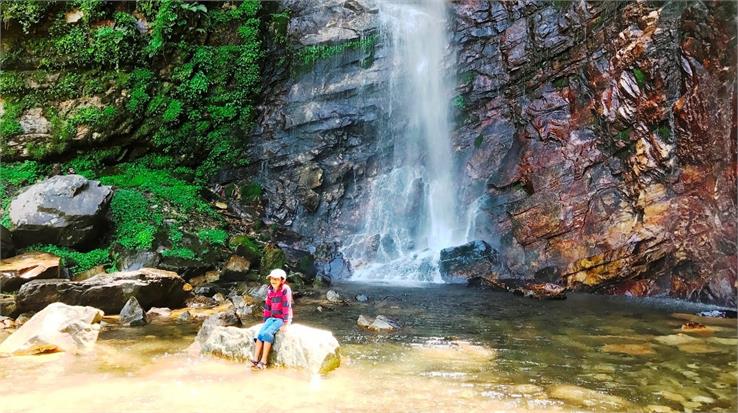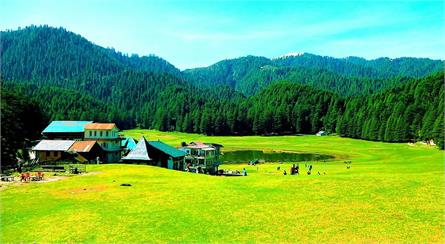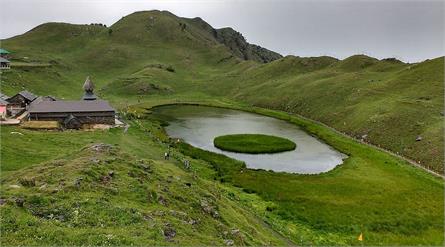Tirthan Valley: The Unspoiled Beauty of the Himalayas

# Tirthan Valley # An Emerging Destination !
Kullu district of Himachal Pradesh is a mountainous region and a district of valleys. Many big and small rivers flow in these valleys. Suppose such a hilly area has been resided in the Western Himalayas, full of natural beauty and resources. In that case, most of its location is full of forests, rivers, drains, lakes, springs and slopes, where very few people reside. That hilly area is the Tirthan Valley which sits at an altitude of 1600 m above the sea level of the Kullu district of Himachal Pradesh.
It is a peaceful escape from the hustle and bustle of city life. The rivers, streams, lakes and waterfalls beautify the landscape. There are waves of natural music. The traditional fairs and festivals present evidence of glorious history. Whether it is a matter of faith, lifelike scenes or the unique treasures of biological diversity, there is no comparison of Tirthan Valley.
It gives a feel of winter, even in summer. If you plan to go somewhere in the mountains in summer and need more time, Tirthan Valley can be a fantastic place. Here you will find everything you want to do in the mountains, like- Hiking, Trekking, Waterfalls, Lakes, Historical sites etc. The form of Tirthan Valley is rural and mountainous. Hence it is an emerging area in terms of rural and adventure tourism. Tirthan Valley contains priceless treasures of art, culture, ancient customs, religious traditions, natural resources and biological diversity. Savoury and charming valleys are quickly attracting tourists.
Also Read: Dalhousie
Wheather

During the summer, there is greenery all around the valley, which makes the view of the Tirthan valley colourful. In contrast, during the snowfall in the winter, the entire Tirthan Valley is covered with a white sheet of snow, offering a panoramic view.
The lowland ecozone of the Tirthan Valley receives less snowfall, while the higher core zone has covered with snow in winter. Here the waterfalls, rivers, streams, lakes, forests, mountains and slopes present unique views of the beauty of this valley. At the beginning of the season, the temperature usually ranges between 7°C and 18°C.
However, as the season progresses, the area of Tirthan Valley receives snowfall, which causes the mercury level to drop to 1°C. December and January are the coldest months in the region. So, if you plan to visit Tirthan Valley during these months, pack warm clothes to stay comfortable.
Best Time To Visit
Tirthan Valley is a place that you can visit any time of the year. However, plan your trip from March to July if you want to experience the peak tourist season. During this time, you will encounter many tourists exploring the Tirthan Valley.
Best Places To Visit
There are many picturesque places and valleys for tourists to roam in Tirthan Valley. Visitors can enjoy other adventures and activities like trekking, camping, and fishing in Eco John and Core John area from 1 day to 15 days. There are many untouched picturesque places in the Tirthan Valley where the tourists have yet to step.
At present, places like Great Himalayan National Park, Tirth, Rola, Pekhari, Bunga, Saur, Rangtad, Chhoi Waterfall, Sharchi Jamala, Baddasari, Lambhri, Bashleu Pass have become centres of tourist attraction in the Tirtha Valley. Apart from this, many other beautiful areas in the Tirthan Valley , like Shili Sharunagar, Mashiyar, Kandi Galu, Thari, Basheer, and Sri Kot, are still waiting for tourists—the information of some best places has given below.
1. Great Himalayan National Park
The Great Himalayan National Park, located in the Tirthan Valley of Banjar, a remote region of the Western Himalayas, has given UNESCO World Heritage status in 2014. This national park is one of India's most beautiful, with an area of over 765 square kilometres. There is a unique natural beauty and a unique treasure of biological diversity here.
The importance of this national park is the rarest biological diversity found here. It has many birds and animals like wild animals, pyre, bears, Ghoral, Kakad, Jeju Rana, Monal and forest flora and medicinal herbs. The speciality of this park is that those species of wild animals and birds still found here are on the verge of becoming rare worldwide. Whether about wild animals, birds or medicinal herbs, the park area is attracting researchers, adventure lovers and trekkers. Earlier, sheep and goat rearers, called foals/shepherds, used to go to this park area.
2. Gushaini
Gushaini is a charming village to visit in Tirthan Valley. It is said to be the starting point for many treks in the area and has located on the banks of the picturesque Tirthan River. The locals are friendly and cheerful, and the village has surrounded by lush greenery and orchards full of delicious fruits.
The rustic wooden buildings and houses add to the village's charm. The confluence of the Tirthan Valley and Flachan Rivers is nearby and worth a visit.
3. Tirthan Valley Trek

Still, tourists, nature lovers and trekkers from all over the country and abroad are eager to measure the heights here and touch the peak even in difficult geographical conditions. Tourists can enjoy adventure activities like camping, trekking, fishing, river crossing, and mountaineering in this Tirthan Valley. The local people here have traditionally played an essential role in preserving and conserving the Tirthan Valley.
4. Tirthan River
The importance of Tirthan Valley is due to the Tirthan River originating from a place called Tirtha, a remote place in the park area. This valley is called Tirthan Valley because of the river Tirthan and the beautiful valleys on both sides. The site of origin of the Tirthan River is considered very sacred in the local Dev tradition.
Apart from being holy, there is also a treasure of natural beauty, biological diversity and rare herbs with medicinal properties. Hence, these herbs make the water of the Tirthan River therapeutic. The water of the Tirthan River is considered essential for worship in the Tirthan Valley. People who cannot reach the pilgrimage take a bath at Gushaini, fill the river's water and take it with them to worship this river. Water can also be drunk. The Tirthan River from the Himkhand mountain pilgrimage is known for its pure and clean water.
5. Shringa Rishi Temple
Shringa Rishi Temple is a remarkable place dedicated to sage Rishyasringa, the ruling deity of Banjar Valley. The temple is of great historical significance and boasts a Pagoda-style design with three floors that offer breathtaking panoramic views of the lush green landscapes.
Inside the temple are the idols of Shringa Rishi and Shanta, who have believed to protect the temple from negative energies. It has fascinating to learn that Shringa Rishi Temple was once a meditation centre for many sages, making it an ideal spot for those searching for inner peace.
6. Serolasar Lake

Serolasar Lake is a must-visit destination around Tirthan Valley that you would want to take advantage of. It has located about 5 km from the Jalori Pass and boasts an altitude of roughly 3,100 meters.
This lake is said to have some incredible medicinal properties, which makes it all the more appealing to tourists and locals alike. The natural beauty of this place is simply breathtaking and is one of the reasons why there are so many visitors here all year round. Just keep in mind that getting here requires a bit of trekking.
7. Jalori Pass
Jalori Pass is a beautiful destination near Tirthan Valley. The Dhauladhar mountain range's natural beauty has fully displayed from here, and it is truly mesmerizing. The panoramic views alone are worth the visit.
8. Scenic villages
Exploring the scenic villages of Tirthan Valley is an experience like no other. The small roads that wind through the beautiful woods and rice terrace farms lead to tiny hamlets and villages, each lovelier than the next.
Spending a day or night with cheerful and welcoming locals is the perfect way to rejuvenate your weary soul. You might even get a chance to witness their legendary wood-carving skills, which are an integral feature of almost all the temples in Kullu Valley.
Also Read: Jakhu Hill
Where To Stay?
Apart from the rest houses of government departments, there are many private homestays, cottages and camps etc., to stay Tirthan Valley. There are some best stays in Tirthan Valley with beautiful looks and architecture given below.
1. Tirthan Holiday Camp And Cottages
Raju Bharti's Guest House in Tirthan Valley is lovely, with beautiful surroundings and delicious food. Anyone looking for a peaceful and comfortable stay in the Tirthan Valley would be interested in this option.
Additionally, Tirthan Holidays Camp and Cottages seem like amazing place to spend a week-long vacation and enjoy the beauty of nature. With its breathtaking mountain views, it's sure to leave a lasting impression on anyone who visits.
2. Raju Bharti’s Guest House
Another great hotel in Tirthan Valley is called Raju Bharti's Guest House. It offers basic amenities and spectacular dining options. The food is said to be just like homemade meals.
The garden is filled with butterflies, cats, and dogs which would make it a paradise for pet and nature lovers. The starting price per night is between INR 3000 to INR 4000.
3. White Stone Cottages
Whitestone Cottages in Tirthan Valley is a great place to stay if you're looking for a cosy retreat with fantastic balcony views, delicious food, and plenty of adventurous activities.
The rooms are tastefully decorated and offer beautiful mountain views from the windows. It has the perfect place to relax and unwind. The starting price per night is INR 5000 to INR 6000.
How To Reach Tirthan Valley
Generally, the journey to Tirthan Valley starts from a small town called Gushaini, the focal point of the valley. Tourists can easily reach this place by road from Delhi, Chandigarh, Shimla, Manali, Kullu, Bhuntar and Out through their private vehicles, taxis and buses. One can travel by air to Kullu Manali Airport Bhuntar and by rail to Ambala.
1. By Air
You can reach Tirthan Valley by the nearest airport, Bhuntar Airport, also known as Kullu Manali Airport (KUU), around 48-50 km away. It has recommended to take connecting flights from Delhi and Chandigarh.
You can easily book a taxi or public transport to reach the valley upon arrival. If you are travelling from Delhi, you can board Air India flights from Delhi Airport with airfares starting from INR 4,000-5,000. Similarly, if you are from Chandigarh, you can board Air India flights from Chandigarh Airport with airfares starting from INR 7,000- INR 8,000.
2. By Rail
Ambala and Kirtapur are the two options available, and both are well-connected with nearby towns and cities. However, considering the distance, it might be better to deboard at Kiratpur, the nearest station. After that, you can take a taxi or some other means of public transport to travel to the Tirthan Valley.
3. By Road
There are several transportation options available. State-run buses and private buses are frequently available to and from the area. Additionally, the roadways to Himachal are well-structured and maintained, making it an excellent option to consider booking a taxi or travelling via vehicle. If you are from Chandigarh, the distance is 250 km via NH154. From Ludhiana, it's 293 km via NH205, and from Sirsa, it's 474 km via NH205.




















